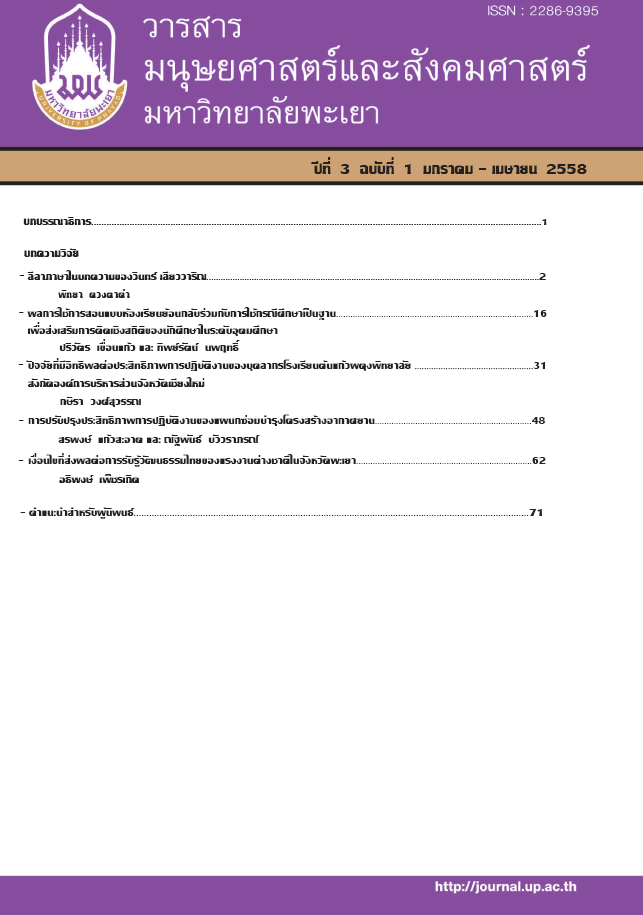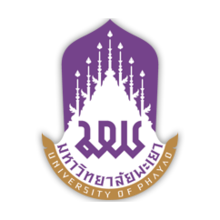Effect of using Flip Classroom and Case-based Learning for enhancing Statistical Thinking of Students in Higher Education
Keywords:
Flip Classroom, Case-based Learning, Statistical ThinkingAbstract
The purpose of this research was to study the effect of using flip classroom and case-based learning for enhancing statistical thinking of students in higher education. Target group were 35 undergraduate students of the management sciences faculty, majoring business computer, Chiangmai Rajabhat University, who enrolled research of business computer course (BCOM3201) in the 1st Semester, academic year 2014. The instruments used in this research were 1) lesson plan 2) the statistical thinking level evaluating criteria 3) the statistical thinking level record form and 4) field note. Data about the level of statistical thinking were analyzed using frequency and percentage to compare the changing of the student’s statistical thinking level between online-classroom and in-classroom. Data obtained from observations, interviews and reflective thinking of learners were analyzed using content analysis.
The results were as follow:
- Most students of the target group were higher statistical thinking level after learning in flip classroom and case-based learning. Recognition of the need for the data aspect: most students of the target group were idiosyncratic level in online-classroom and increase to Quantitative level in in-classroom. Consideration of Variation aspect: most students of the target group were idiosyncratic level in online-classroom and increase to transitional level in in-classroom.
- Most students of the target group could learn by themselves through online-classroom, use knowledge to solve problems in the case studies and exchange the ideas through social network before going to in-classroom. In-classroom, there were brainstorming groups and collaborating within the group and knowledge-sharing among the group. Students shared the work within the group and learned to work together as a team effectively.
- Problems found in research were 1) students have not well enough statistical basis and 2) they could not use computer programs to analyze the information effectively. The cause of enhancing the statistical thinking in consideration of variation aspect was still not on the target. The target group needed to review their knowledge in statistics and the use of computer programs.
References
ตะวัน เทวอักษร. The Flipped Classroom เรียนแบบ “พลิกกลับ” ห้องเรียนยุคใหม่แห่งศตวรรษที่ 21. School in focus. 2555; 4(11): 17-19.
ธีระชัย ปูรณโชติ. การเรียนการสอนที่เน้นผู้เรียนเป็นสำคัญ: แนวคิด วิธีและเทคนิคการสอน.กรุงเทพฯ : บริษัท เดอะมาสเตอร์กรุ๊ป แมเนจเม้นท์ จำกัด; 2544.
นิตยา โสรีกุล. ผลการใช้การสอนแนะในการเรียนรู้ด้วยกรณีศึกษาบนเว็บที่มีต่อการแก้ปัญหาของนักเรียนชั้นมัธยมศึกษาปีที่ 1 ที่มีรูปแบบการคิดต่างกัน. วิทยานิพนธ์ปริญญามหาบัณฑิต ภาควิชาหลักสูตรการสอนและเทคโนโลยีการศึกษา คณะครุศาสตร์ จุฬาลงกรณ์มหาวิทยาลัย; 2547.
นิรมล ศตวุฒิ. การจัดการเรียนรู้ที่เริ่มจากผู้เรียน. วงการครู. 2547; 1(7): 8
พิศิษฐ ตัณฑวณิช. สถิติเพื่องานวิจัยทางการศึกษา. พิมพ์ครั้งที่ 5. นนทบุรี : บุ๊ค พอยท์; 2553.
ฟาฏินา วงศ์เลขา. ห้องเรียนกลับทาง : เปลี่ยนห้องเรียนเป็นพื้นที่เรียนรู้; 2556:[1]. ได้จาก http://www.dailynews.co.th/Content/education/143051/ห้องเรียนกลับทาง+%3A+เปลี่ยนห้องเรียนเป็นพื้นที่เรียนรู้. (3 มีนาคม 2557)
รามนรี ภูดีบุตร. การพัฒนากรอบแนวคิดของการคิดเชิงสถิติ. วิทยานิพนธ์ ปริญญาครุศาสตรดุษฏีบัณฑิต สาขาวิชาคณิตศาสตร์ศึกษา. มหาสารคาม : บัณฑิตวิทยาลัย มหาวิทยาลัยราชภัฏมหาสารคาม;2556.
วิจารณ์ พานิช. ครูเพื่อศิษย์สร้างห้องเรียนกลับทาง. กรุงเทพ : เอสอาร์พริ้นติ้งแมสโปรดักส์ จำกัด; 2556.
วิรัช วรรณรัตน์. การวัดและประเมินผลการศึกษา. กรุงเทพฯ : สำนักทดสอบทางการศึกษาและจิตวิทยา มหาวิทยาลัยศรีนครินทรวิโรฒ ประสานมิตร; 2539.
สวนีย์ จำเริญวงศ์. การใช้สถานการณ์จำลองเพื่อศึกษากระบวนการคิดเชิงสถิติเกี่ยวกับการทดสอบสมมติฐาน สำหรับนักศึกษาชั้นปีที่ 1. ขอนแก่น: มหาวิทยาลัยขอนแก่น; 2551.
สุวิทย์ มูลคำ และอรทัย มูลคำ. 21 วิธีจัดการเรียนรู้ : เพื่อพัฒนากระบวนการคิด. พิมพ์ครั้งที่ 1. กรุงเทพฯ : ภาพพิมพ์; 2551.
สุภาณี เส็งศรี. การพัฒนาระบบการเรียนการสอนทางไกลในสถาบันอุดมศึกษา. วิทยานิพนธ์ปริญญาดุษฎีบัณฑิต. จุฬาลงกรณ์มหาวิทยาลัย; 2543.
สูติเทพ ศิริพิพัฒนกุล. การพัฒนาความสามารถในการแก้ปัญหาและการเรียนรู้เป็นทีมของนิสิตปริญญาบัณฑิตด้วยรูปแบบการเรียนแบบผสมผสานที่ใช้เทคนิคการเรียนร่วมกันด้วยกรณีศึกษาและเทคโนโลยีการแลกเปลี่ยนเรียนรู้ที่ต่างกัน. วิทยานิพนธ์ปริญญาครุศาสตร์ดุษฏีบัณฑิต ภาควิชาเทคโนโลยีและสื่อสารการศึกษา คณะครุศาสตร์ จุฬาลงกรณ์มหาวิทยาลัย; 2553.
เสริมศรี ไชยศร. พื้นฐานการสอน. เชียงใหม่ : ลานนาการพิมพ์; 2539.
สำนักงานคณะกรรมการการศึกษาอุดมศึกษา. กรอบมาตรฐานคุณวุฒิระดับอุดมศึกษาแห่งชาติ พ.ศ. 2552. กรุงเทพฯ : สำนักงานคณะกรรมการการศึกษาอุดมศึกษา; 2552.
Aaron Sams, Jon Bergmann, Kristin Daniels, Brian Bennett, Helaine W. Marshall and Kari M. Arfstrom. What Is Flipped Learning?. 2014. [2 pages]. Available from: URL: http://www.flippedlearning.org/cms/lib07/ VA01923112/Centricity/Domain/46/FLIP_handout_FNL_Web.pdf. 02 April 2014.
Downloads
Published
How to Cite
Issue
Section
License
ผู้นิพนธ์ต้องรับผิดชอบข้อความในบทนิพนธ์ของตน มหาวิทยาลัยพะเยาไม่จำเป็นต้องเห็นด้วยกับบทความที่ตีพิมพ์เสมอไป ผู้สนใจสามารถคัดลอก และนำไปใช้ได้ แต่จะต้องขออนุมัติเจ้าของ และได้รับการอนุมัติเป็นลายลักษณ์อักษรก่อน พร้อมกับมีการอ้างอิงและกล่าวคำขอบคุณให้ถูกต้องด้วย
The authors are themselves responsible for their contents. Signed articles may not always reflect the opinion of University of Phayao. The articles can be reproduced and reprinted, provided that permission is given by the authors and acknowledgement must be given.







